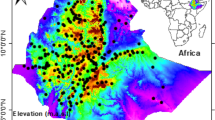Abstract
Climate variability has been a crosscutting issue across the globe, where the effect is more adverse in developing countries such as Ethiopia. The study aimed at investigating climate variability of Ziway Dugda and Dodota Woredas, Central Rift Valley, Ethiopia. The study has used 1983–2012, time series gridded data, field survey, and normalized difference vegetation index (NDVI) data. The data were thoroughly processed and analyzed using combination of Geospatial technologies and descriptive statistics. Long-term (1983–2012) rainfall data analysis result revealed an increasing trend, with an overall mounting rate of 78.5 mm in three decades period and it is also characterized by inter-annual fluctuation. The mean maximum total rainfall analysis of the same period divulges a consistent pattern, distinctively featured by late-onset and early cessation of rainfall. It is found that the maximum temperature increased by 0.23 °C per decade with an overall rise of 0.7 °C in the 30-year period of concern, while the minimum temperature remains constant. The statistical correlation result signposted a linear positive correlation between NDVI and mean annual and spring season rainfall with r2 value of 0.3467 and P value of 0.0342, and r2 of 0.715 and P value of 0.0003, respectively. Indisputably, variability of rainfall, and minimum and maximum temperatures was observed. The analysis also stipulated that climate variability is pervasive particularly in the spring rainy season, substantially dwindled in its amount and distribution, and eventually afflicts the vegetation condition and crop production in the milieu. Therefore, as climate variability has been highly manifested in the study area, appropriate policy and strategic measures are required to reduce and mitigate the consequent impacts.















Similar content being viewed by others
Data availability
The main data used for this research were gridded time series metrological data and Normalized Difference Vegetation Index (NDVI). The metrological data was obtained from National Metrological Agency of Ethiopia and the NDVI was derived from the National Aeronautics and Space Administration (NASA), MODIS terra sensor (via http://earthexplorer.usgs.gov/), an open-source data repository widely available for research purpose free of charge.
In addition, Auxiliary data’s such as study area administrative boundary, road network, rivers, towns were obtained from the Ethiopian Geospatial Information Institute.
Code availability
Not applicable.
References
Adger NW, Saleemul H, Brown K, Conway D, Hulme M (2003) Adapting to climate change in the developing world. Prog Dev Stud 3(3):179–195
Agnew CT, Chappell A (2000) Drought in the Sahel_Zeng. GeoJournal 48:299–311 (1999. © 2000 Kluwer Academic Publishers. Printed in the Netherlands. Pdf, 299–300)
Ahmed K et al (2019) ‘Evaluation of gridded precipitation datasets over arid regions of Pakistan’, Water (Switzerland) 11(2). https://doi.org/10.3390/w11020210
Ayalew D, Tesfaye K, Mamo G, Yitaferu B, Bayu W (2012) Variability of Rainfall and its Current Trend in Amhara Region, Ethiopia. Afr J Agric Res 7(10):1475–1486. https://doi.org/10.5897/AJAR11.698
Conway D, Schipper ELF (2011) Adaptation to climate change in Africa : challenges and opportunities identified from Ethiopia. Glob Environ Chang 21(1):227–237. https://doi.org/10.1016/j.gloenvcha.2010.07.013
Conway G (2009) The science of climate change in Africa : impacts and adaptation. (1), 1–24. Grantham Institute for Climate Change, Discussion Paper No 1, Imperial College, London
Dare O, Wolski P, Ngwenya B, Mmopelwa G (2014) Climate risk management ethno-meteorology and scientific weather forecasting: small farmers and scientists ’ perspectives on climate variability in the Okavango Delta, Botswana. Clim Risk Manag 4–5:43–58. https://doi.org/10.1016/j.crm.2014.08.002
Feyissa G (2010) Comparative analysis of climate variability and impacts in central rift valley and adjacent arsi highlands using gis and remote sensing. Retrieved from http://etd.aau.edu.et/handle/123456789/6593. Accessed 20 Aug 2019
Forster P, Ramaswamy V, Artaxo P, Berntsen T, Betts R, Fahey DW, Haywood J, Lean J, Lowe DC, Myhre G, Nganga J, Prinn R, Raga G, Schulz M, and Dorland V (2007) Changes in atmospheric constituents and in radiative forcing. In: Climate Change. The Physical Science Basis. Cambridge University Press, Cambridge, United Kingdom and New York, NY, USA
Gebreegziabher Z, Stage J, Mekonnen A, Alemu A (2011) Climate change and the ethiopian economy: a computable general equilibrium analysis. Environment for Development. EfD DP 11-09
Hadgu G, Tesfaye K, Mamo G, Kassa B (2015) Farmers’ climate change adaptation options and their determinants in Tigray Region, Northern Ethiopia. Afr J Agr Res 10(9):956–964. https://doi.org/10.5897/AJAR2014.9146
Hansen J, Sato M, Ruedy R, Lo K, Lea DW, and Medinaelizade M (2006) Global temperature change. National Aeronautics and Space Administration Goddard Institute for Space Studies, Columbia University Earth Institute, and Sigma Space Partners, Inc., 2880 Broadway, New York, NY 10025; and Department of Earth Science, University of California, Santa Barbara, CA 93106. https://doi.org/10.1073/pnas.0606291103
IPCC (Intergovernmental Panel on Climate Change) (2001) Climate change 2001: synthesis report. In: Watson RT and the core writing team (eds) A contribution of working groups I, II, and III to the third assessment report of the intergovernmental panel on climate change. Cambridge University Press, Cambridge, United Kingdom, and New York, NY, USA, p 398
IPCC (Intergovernmental Panel on Climate Change) (2007) Climate Change 2007: the physical science basis. Constribution of working Group I to the Fourth Assessment Report. Cambridge Univeristy Press, Cambridge, United Kingdom and New York, NY, USA
IPCC (Intergovernmental Panel on Climate Change) (2012) Managing the risks of extreme events and disasters to advance climate change adaptation climate change. Special report of the Intergovernmenrtal Panel on Climate Change, Cambridge University Press 32 Avenue of the Americas, New York, NY 10013–2473, USA
Jansen HC, Harmsen J, Hengsdijk H, Dagnachew L, Tenalem A, Hellegers P, Spliethoff P (2007) Land and water resources assessment in the Ethiopian Central Rift Valley. Alterra Wageningen UR, p 44
Jantakat Y, and Ongsomwang S (2011) Assessing the effect of incorporating topographical data with geostatistical interpolation for monthly rainfall and temperature in Ping Basin, Thailand. 18(2):123–139
Kadir T, Mazur L, Milanes C, Pham N, Randles K (2013) Recent research on climate change: an annotated bibliography with an emphasis on California. Air, community and environmental research branch office of environmental health hazard assessment California environmental protection agency. Integrated Risk Assessment Branch Office of Environmental Health Hazard Assessment California Environmental Protection Agency. Retrieved from https://oehha.ca.gov/media/downloads/climate-change/report/climatechangebibliooctober2013.pdf. Accessed 10 Sept 2019
Kassie BT et al (2013) Climate variability and change in the Central Rift Valley of Ethiopia: Challenges for rainfed crop production. J Agric Sci 152(1):58–74. https://doi.org/10.1017/S0021859612000986
Kursinski AL, Zeng X (2006) Areal estimation of intensity and frequency of summertime precipitation over a midlatitude region. Geophys Res Lett 33:1–5. https://doi.org/10.1029/2006GL027393
Liu Y et al (2022) An assessment of statistical interpolation methods suited for gridded rainfall datasets. Int J Climatol 42(5):2754–2772. https://doi.org/10.1002/joc.7389
Ly S, Charles C, Degré A (2011) Geostatistical interpolation of daily rainfall at catchment scale: the use of several variogram models in the Ourthe and Ambleve catchments, Belgium. Hydrol Earth Syst Sci 15(7):2259–2274. https://doi.org/10.5194/hess-15-2259-2011
Measho S et al (2019) Spatio-temporal analysis of vegetation dynamics as a response to climate variability and drought patterns in the semiarid region, Eritrea. Remote Sens 11(6):724. https://doi.org/10.3390/rs11060724
Mera AG (2018) Drought and its impacts in Ethiopia. Weather Clim Extremes 22(2018):24–35
Morton JF (2007) The impact of climate change on smallholder and subsistence agriculture. Proc Natl Acad Sci 104(50):19680–19685. https://doi.org/10.1073/pnas.0701855104
National Metrological Agency (NMA) (2001) Initial National Communication of Ethiopia to the United Nations Frame-Work Convention on Climate Change (UNFCCC). Addis Ababa, Ethiopia.
Nguyen K, Liou Y (2019) Science of the total environment global mapping of eco-environmental vulnerability from human and nature disturbances. Sci Total Environ Elsevier B.V. 664:995–1004. https://doi.org/10.1016/j.scitotenv.2019.01.407
National Metrological Agency (NMA) (2007) Ethiopia climate change national adaptation programme of action (NAPA) of Ethiopia. Addis Ababa, Ethiopia
Oxfam (2017) A climate in crisis. How climate change is making drought and humaniterian disaster worse in East Africa. Oxfam media briefing. Retieved from https://www-cdn.oxfam.org/s3fs-public/mb-climate-crisis-east-africa-drought-270417-en.pdf. Accessed 23 Aug 2019
Pandey RS, Liou Y (2020) Decadal behaviors of tropical storm tracks in the North West Pacific Ocean. Atmos Res Elsevier 246:105143. https://doi.org/10.1016/j.atmosres.2020.105143
Rosell S (2011) Regional perspective on rainfall change and variability in the central highlands of Ethiopia, 1978–2007. Appl Geogr 31(1):329–338. https://doi.org/10.1016/j.apgeog.2010.07.005
Sttoquart Z et al (2005) The SIA method for spatial analysis of precipitation in the upper-middle reaches of the Yangtze River. 2(2001):2001–2002. https://doi.org/10.1360/gs050211
Tessema YA, Aweke CS and Endris GS (2013) Understanding the process of adaptation to climate change by small-holder farmers : the case of east Hararghe Zone, Ethiopia, (May 2016):1. https://doi.org/10.1186/2193-7532-1-13
Thornton PK et al (2006) Mapping climate vulnerability and poverty in Africa. Report to the department for international development. The International Livestock Research Institute (ILRI), Nairobi
Tura FS (2017) ‘Climate variability and drought in the past 30 years in central rift valley of Ethiopia’, J Nat Sci Res 7(9):18–26. Available at: ISSN 2224–3186 (Paper) ISSN 2225–0921
UNFCCC (2007) Climate change: impacts, vulnerabilities and adaptation in developing countries. Climate Change Secretariat (UNFCCC), Bonn, p 68
USAID (2006) Agro-climatic monitoring. Famine Early Warning System Network (FEWSNET). Retrieved from https://fews.net/. Accessed 3 Sept 2019
U.S. Global Change Research Program (2017) Climate science special report. Fourth National Clim Assess 1
Wackernagel H (2003) Multivariate geostatistics: an introduction with applications. Springer-Verlag, Berlin. https://doi.org/10.1007/978-3-662-05294-5
WMO (2005) World Meteorological Organization Annual Report 2005. Weather, climate, water and sustainable development (Issue 1000). Retrieved from https://library.wmo.int/doc_num.php?explnum_id=7677. Accessed 15 Sept 2019
World Bank (2009) Africa region making development climate resilient: a World Bank strategy for Sub-Saharan Africa 46947. https://openknowledge.worldbank.org/bitstream/handle/10986/3211/469470ESW0Whit0t20100Full0vNoImages.pdf?sequence=1&isAllowed=y. Accessed 7/9/2019
Yang JS (2004) Estimation of land surface temperature using spatial interpolation and Satellite-derived surface emissivity. J Environ Inf 4(1):40–47. https://doi.org/10.3808/jei.200400035
Yazachew E, Kasahun D (2011) The National Regional Govermant of Oromia Physical and Socio economic Profile of Arsi Zone and districts bureau of finance and d economic development – regional data and information core process 1–496
Funding
This research was financially supported by Ministry of Science and Technology (MOST) of Taiwan under the codes MOST 109–2923-E-008–004-MY2 and MOST 108–2111-M-008–036-MY2.
Author information
Authors and Affiliations
Contributions
The authors confirm contribution to the paper as follows: study conception, data collection: Esubalew Nebebe Mekonnen, Dr. Shimeles Damene, Dr. Ephrem Gebremariam; analysis and interpretation of results: Esubalew Nebebe Mekonnen, Professor Liou, Dr. Shimeles Damene, Dr. Getachew Mehabie Mulualem; draft manuscript preparation: Esubalew Nebebe Mekonnen, Professor Liou, Dr. Shimeles Damene, Dr. Ephrem Gebremariam, and Dr. Getachew Mehabie Mulualem. Revising the manuscript: Esubalew Nebebe Mekonnen, Professor Liou, Dr. Shimeles Damene, Dr. Ephrem Gebremariam, and Dr. Getachew Mehabie Mulualem. All authors reviewed the results and approved the final version of the manuscript.
Corresponding author
Ethics declarations
Ethics approval
Not applicable.
Consent to participate
Household survey and key informants’ interview were employed in this research. Both participants were selected in this study after a full consent was obtained from each participant.
Consent for publication
This is to certify that this research is an original research work; it has not been published elsewhere nor it is currently under consideration for publication.
Conflict of interest
The authors declare no conflict of interest.
Additional information
Publisher's note
Springer Nature remains neutral with regard to jurisdictional claims in published maps and institutional affiliations.
Rights and permissions
Springer Nature or its licensor (e.g. a society or other partner) holds exclusive rights to this article under a publishing agreement with the author(s) or other rightsholder(s); author self-archiving of the accepted manuscript version of this article is solely governed by the terms of such publishing agreement and applicable law.
About this article
Cite this article
Mekonnen, E.N., Liou, YA., Damene, S. et al. Geospatial-based climate variability analysis, in Central Ethiopia Rift Valley. Theor Appl Climatol 152, 151–165 (2023). https://doi.org/10.1007/s00704-023-04376-6
Received:
Accepted:
Published:
Issue Date:
DOI: https://doi.org/10.1007/s00704-023-04376-6




